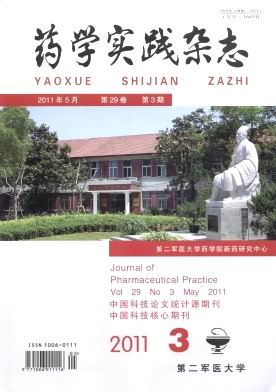|
[1]
|
Dreher MR, Liu W, Michelich CR, et al. Tumor vascular permeability, accumulation, and penetration of macromolecular drug carriers[J]. Natl Cancer Inst,2006,98(5):335. |
|
[2]
|
Nomura T, Koreeda N, Yamashita F, et al. Effect of particle size and charge on the disposition of lipid carriers after intratumoral injection into tissueisolated tumors[J]. Pharm Res,1998,15(1):128. |
|
[3]
|
Soundararajan A, Bao A, Phillips WT, et al.[186Re]Liposomal doxorubicin (Doxil): in vitro stability, pharmacokinetics, imaging and biodistribution in a head and neck squamous cell carcinoma xenograft model [J]. Nucl Med Biol,2009,36(5):515. |
|
[4]
|
Rosenthal E, Poizot-Martin I, Saint-Marc T, et al. Phase IV study of liposomal daunorubicin (DaunoXome) in AIDS-related Kaposi sarcoma[J]. Am J Clin Oncol,2002,25(1): 57. |
|
[5]
|
Rawat M, Singh D, Saraf S,et al. Nanocarriers: promising vehicle for bioactive[J]. Biol Pharm Bull,2006,29(9):1790. |
|
[6]
|
Zhan CY, Gu B, Xie C,et al. Cyclic RGD conjugated poly(ethylene glycol)-co-poly(lactic acid) micelle enhances paclitaxel anti-glioblastoma effect[J]. J Control Release,2010,143(1):136. |
|
[7]
|
Manchester M,Singh P. Virus-based nanoparticles (VNPs): platform technologies for diagnostic imaging[J]. Adv Drug Deliv Rev,2006,58(14):1505. |
|
[8]
|
Singh P,Destito G,Schneemann A,et al. Canine parvovirus-like particles, a novel nanomaterial for tumor targeting[J]. J Nanobiotechnology,2006,4:2. |
|
[9]
|
Matsumura Y,Maeda H. A new concept for macromolecular therapeutics in cancer chemotherapy: mechanism of tumoritropic accumulation of proteins and the antitumor agent smancs[J]. Cancer Res,1986, 46(12):6387. |
|
[10]
|
Thierry B. Drug nanocarriers and functional nanoparticles: applications in cancer therapy[J]. Curr Drug Deliv,2009,6(4):391. |
|
[11]
|
Ferrari M. Cancer nanotechnology: opportunities and challenges[J]. Nat Rev Cancer ,2005,5(3): 161. |
|
[12]
|
Sapra P,Tyaqi P,Allen TM.Ligand-targeted liposomes for cancer treatment[J]. Curr Drug Deliv,2005, 2(4):369. |
|
[13]
|
Sapra P,Moase EH,Ma J,et al. Improved therapeutic responses in a xenograft model of human B lymphoma (Namalwa) for lipo-somal vincristine versus liposomal doxorubicin targeted via anti-CD19 IgG2a or Fab' fragments[J]. Clin Cancer Res,2004,10(3):1100.[14] Sugano M,Eqilmez NK,Yokota SJ,et al. Antibody targeting of doxorubicin-loaded liposomes suppresses the growth and metastatic spread of established human lung tumor xenografts in severe combined immunodeficient mice[J]. Cancer Res.2000, 60,(24):6942.[15] Goren D,Horowitz AT,Zalipsky S, et al. Targeting of stealth liposomes to erbB-2 (Her/2) receptor: in vitro and in vivo studies[J]. Br J Cancer,1996, 74(11):1749.[16] Heidel JD,Yu Z,Liu JY,et al. Administration in non-human primates ofescalating intravenous doses of targeted nanoparticles containing ribonucleotide reductase subunit M2 siRNA[J]. Proc Natl Acad Sci USA,2007,104(14):5715.[17] Karmali PP,Kotamraju VR,Kastantin M,et al. Targeting of albumin-embedded paclitaxel nanoparticles to tumors[J]. J Nanomedicine,2009, 5(1): 73.[18] Agemy L,Suqahara KN,Kotamraju VR,et al. Nanoparticle-induced vascular blockade in human prostate cancer[J]. Blood,2010,116(15):2847.[19] Blasi F, Carmeliet P. uPAR: a versatile signaling orchestrator[J]. Nat Rev Mol. Cell Biol,2002,3(12):932.[20] Nguyen DX,Bos PD,Massague J. Metastasis: from dissemination to organ specific colonization[J]. Nat Rev Cancer,2009,9(4):274.[21] Garg A,Tisdale AW,Haidari E,et al. Targeting colon cancer cells using PEGylated liposomes modified with a fibronectin-mimetic peptide[J]. Int J Pharm,2009,366(1-2):201.[22] Elazar V,Adwan H,Buerle T,et al. Sustained delivery and efficacy of polymeric nanoparticles containing osteopontin and bone sialoprotein antisenses in rats with breast cancer bone metastasis[J]. Int J Cancer,2010, 126(7):1749.[23] Galanzha EI, Kim JW,Zhaorov VP.Nanotechnology-based molecular photoacoustic and photothermal flow cytometry platform for in vivo detection and killing of circulating cancer stem cells[J]. J Biophotonics,2009, 2(12):725.[24] Schluep T,Cheng J,Khin KT,et al. Pharmacokinetics and biodistribution of the camptothecin-polymer conjugate IT-101 in rats and tumor-bearing mice[J]. Cancer Chemother Pharmacol,2006,57(5):654.[25] Schluep T,Hwang J,Hildebrandt IJ,et al. Pharmacokinetics and tumor dynamics of the nanoparticle IT-101 from PET imaging and tumor histological measurements[J]. Proc Natl Acad Sci USA, 2009,106(27):11394. |







 DownLoad:
DownLoad: